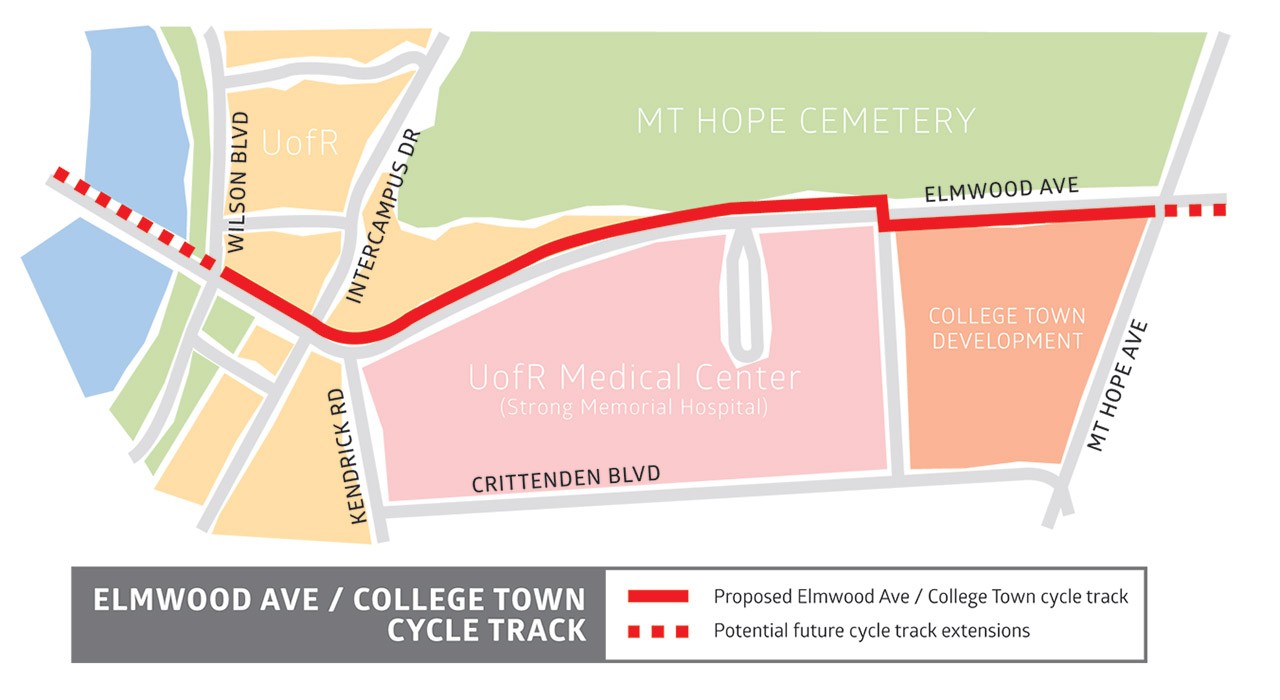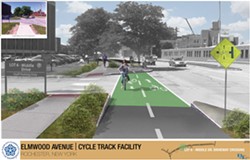The stretch of Elmwood Avenue that runs along the University of Rochester Medical Center campus is a crucial corridor. For many drivers, it's the way they access the UR.
More than 20,000 motor vehicles travel the segment of Elmwood between Mt. Hope Avenue and the Genesee River every day, according to State Department of Transportation data. But hundreds of people also bike through the corridor, says Richard DeSarra, president and co-founder of the Rochester Cycling Alliance.
And the cyclists are often squeezed onto the corridor's sidewalks, he says.
"Even your most experienced cyclists will tell you Elmwood's not a great place to ride," says Erik Frisch, a transportation specialist with the City of Rochester.
The high volume of traffic is only part of the problem. The road has narrow lanes, DeSarra says, which means the motor vehicle traffic is dense. The density, combined with cars changing lanes and making turns, makes many cyclists uncomfortable.

- Map by Matt DeTurck / Data courtesy City of Rochester
City officials say they want to make the street more hospitable to cyclists, and to accomplish that goal they're trying an approach that hasn't been used in Rochester. They're going to build a cycle track along Elmwood between Mt. Hope and the river.
When it's completed, the track will give cyclists a dedicated passageway through the corridor without using an inch of Elmwood's pavement. The city plans to build the .75-mile track next year. Earlier this year, the city received a $1 million state grant to fund most of the $1.5 million project; College Town's developer is chipping in $250,000 for the project.
Over the past couple of years, the city has worked to make its streets more accommodating to cyclists. Crews created bike lanes and laid down shared use markings — sharrows, for short — on many city streets.

- RENDERING COURTESY CITY OF ROCHESTER
- This conceptual drawing shows what the proposed Elmwood-College Town cycle track could look like, though it'll be located on the side of Elmwood opposite what's pictured here.
But Elmwood doesn't have room for bike lanes or sharrows, which is why the cycle track is the most promising option, says city engineer Jim McIntosh.
"It will be used by a lot of people who work on the River Campus," DeSarra says.
Cycle tracks aren't on-street enhancements like bike lanes or sharrows, which are mostly set apart through striping and markings. And unlike bike paths, cycle tracks aren't detached from the roads. In simple terms, cycle tracks resemble scaled-down, bike-only streets.
The typical cycle track runs adjacent to a roadway, and the Elmwood-College Town project will follow that model. Though the corridors are physically separated from streets, they tie into them at driveways and intersections.
A cycle track's pavement is usually wide enough to accommodate bike traffic travelling in two directions. The pavement for the Elmwood-College track will be approximately 10 feet wide, striped down the center, and marked to indicate two directions of travel.
The Elmwood-College Town track will also likely have its own traffic signal system, a feature common to cycle tracks.
The project has generated some public curiosity, since it's a first for Rochester. But it's not the only cycle track the city has in the works. The $28.5 million Inner Loop East project, where the city will fill in a portion of the Inner Loop, also calls for a cycle track.
That bike corridor will start at the Chestnut-Monroe intersection and follow Howell Street to Union Street. From there it will follow Union to University Avenue. City officials expect to complete the project by early 2017.
Frisch says it's likely that future city road projects will be evaluated to see whether cycle tracks make sense.
Ultimately, the cycle tracks provide bicyclists with infrastructure for comfort and safety, say McIntosh and Frisch. But there's a bigger picture, too.
As city officials have planned out bike lanes, sharrows, and now cycle tracks, McIntosh says, they've focused on making a network that mimics the road network that motor vehicles use.
The Elmwood-College Town cycle track fits that philosophy, although it may not be immediately apparent. The track project directly ties in to planning and projects that have come out of Brighton.
The town's Bicycle Master Plan proposes bicycle accommodations — potentially including shared-use lanes — for the entire Elmwood Avenue corridor, from Twelve Corners to the city line. The town and the city are also working together on the Highland Crossing shared-use trail, which would connect a town park off Westfall Road with the Genesee Riverway Trail north of the University of Rochester campus.
So the Elmwood-College Town cycle track is the start of what could be a longer bike corridor. The corridor could someday funnel residents from a few neighborhoods and communities to their jobs or classes on the University of Rochester campus, to new retail on Mt. Hope, or over to the Genesee Riverway Trail, which extends into downtown.